Digital Signage LED Displays: Technology, Applications, and Benefits
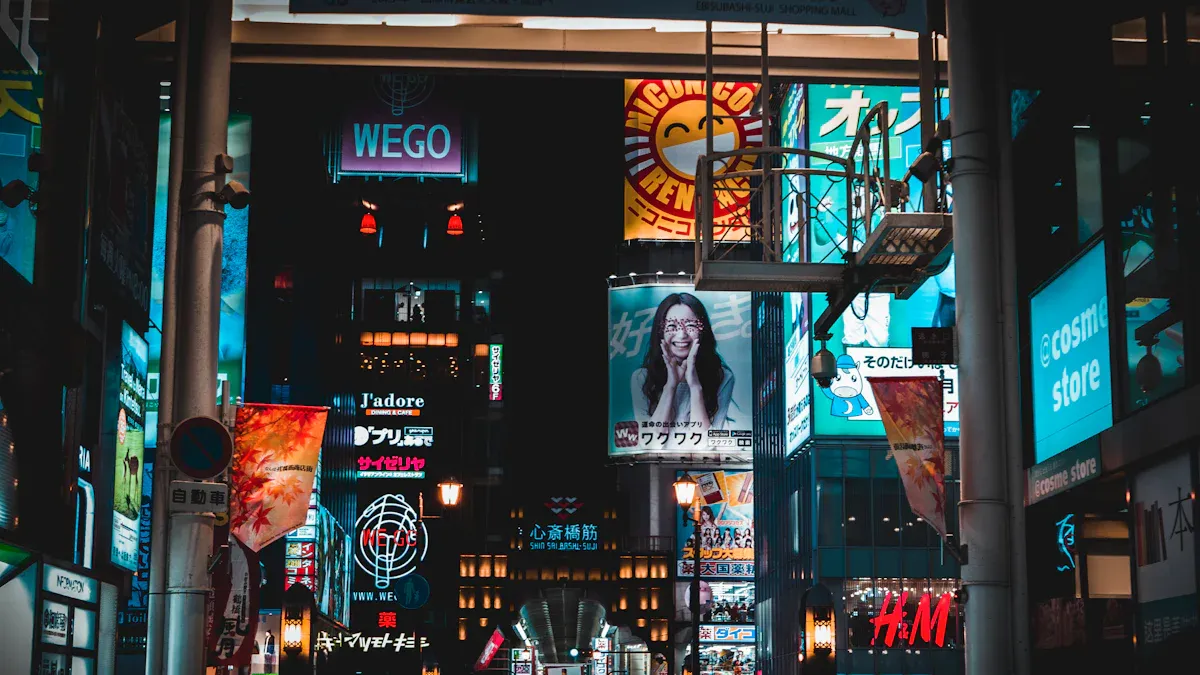
Digital signage LED screens are modern tools for sharing information. They use LED technology to show pictures, text, and videos instantly. You can find them in stores, airports, and hospitals. These screens help people understand messages better and improve experiences.
Businesses use these screens to make exciting digital ads that grab attention. Features like touchscreens or large video walls turn boring messages into fun visuals. They also let people interact with the screens, making them useful for many industries.
Digital signage helps share content easily and clearly. Tools like digital screens and media players make messages smooth to deliver. They help businesses connect with people and share ideas better.
Key Takeaways
Digital signage LED screens help businesses share clear and fun messages. This makes it easier to connect with people.
These screens save energy, using up to 75% less power than older lights. This helps businesses save money over time.
Businesses using these screens see more customer interest. Studies show a 30% increase in attention and a 29.5% rise in sales.
LED screens work well indoors and outdoors. They stay bright in different lighting and weather conditions.
Touchscreen features make these signs more interactive. This doubles user interest and makes experiences more fun and memorable.
Digital Signage and LED Technology
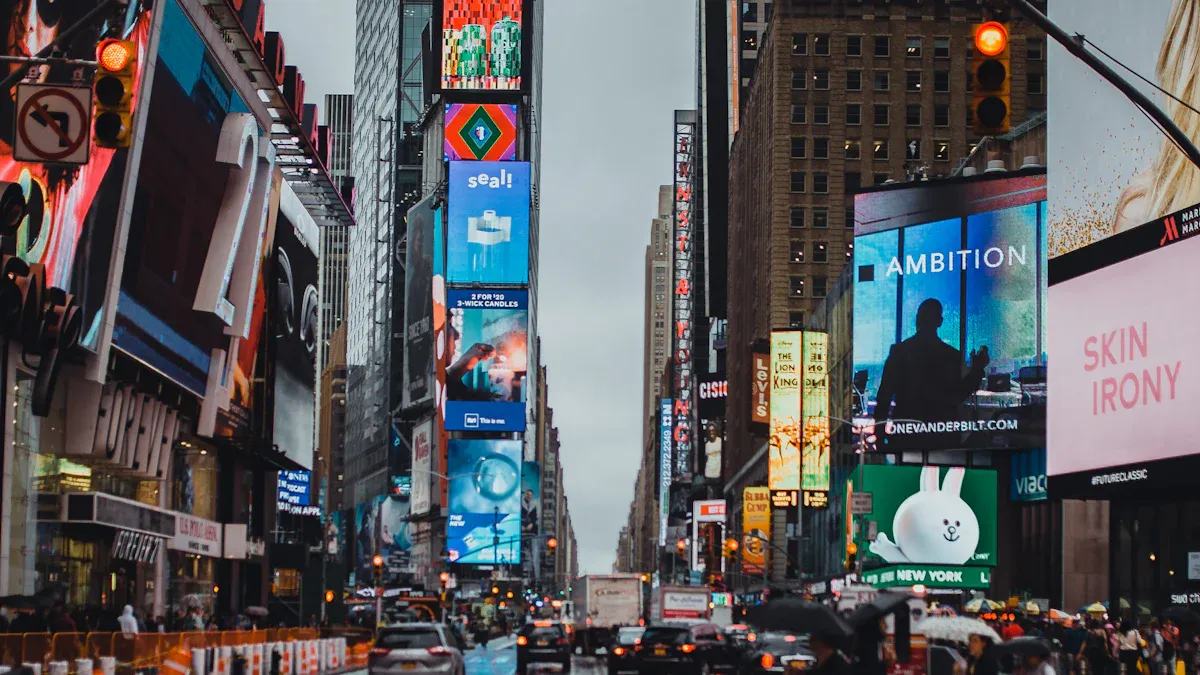
How LED technology powers digital signage
LEDs are small lights that make screens bright and clear. They use less energy than older types of lighting. This makes them great for digital signs. LEDs save up to 75% more energy than regular bulbs. They also last 25 times longer, so screens work for years.
Key components of LED displays
LED screens have parts that work together to show pictures. A driver model controls the power and brightness of the lights. Some models, like the AL58221, can handle up to 12 channels. They also support voltages up to 24V. The refresh rate is over 1,000Hz, so images don’t flicker. Pulse density modulation improves how the visuals look, making them more interesting.
Advancements in LED technology
LED technology has made digital signs better over time. In 2024, the LED signage market was worth $10,718.1 million. It is growing by 8.4% each year until 2030. The digital signage market will grow from $16.3 billion in 2021 to $27.8 billion by 2026. These improvements help people enjoy content more. About 70% of fans say technology makes their experience better. By 2030, LED energy savings will equal the power of 1,000 medium-sized plants. This shows how efficient and cost-saving LEDs are.
Applications of Digital Signage
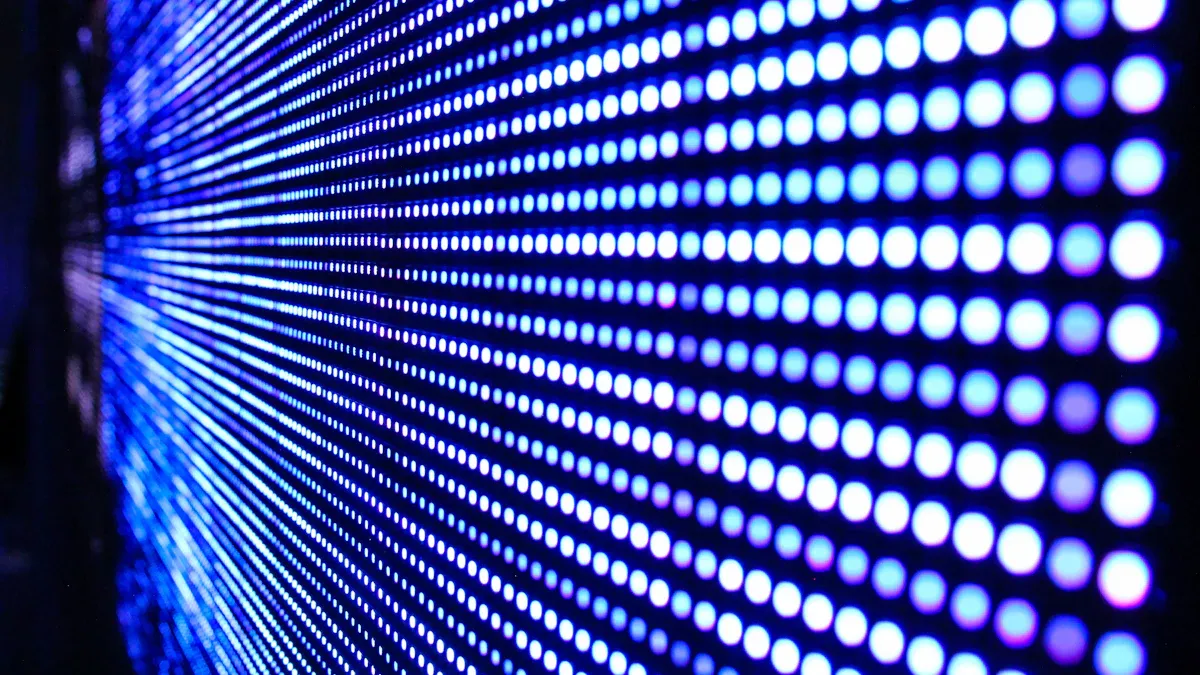
Retail and Shopping Centers
Digital signage has changed how stores connect with shoppers. Bright screens in windows or touch kiosks help people find products. These displays catch attention and affect buying choices. For example, 68% of consumers say digital ads influence their purchases. Also, 70% of adults admit they buy things they didn’t plan after seeing digital signage. This makes it a strong tool for boosting sales.
Stores use digital signage to make shopping more fun. Screens can show deals, new items, or even suggest products. Research shows retail makes up 40% of the digital signage market, proving its value. Plus, 64% of retailers say it helps them engage customers better. 84% agree it improves brand awareness. These numbers show how digital signage can make stores more appealing and keep shoppers coming back.
Statistic | Value |
|---|---|
Shoppers more likely to enter a store due to digital signage | 80% |
Increase in average purchase amounts due to digital signage | 29.5% |
Retailers reporting improved customer engagement with digital signage | 64% |
Retailers agreeing digital signage boosts brand visibility | 84% |
Customers making unplanned purchases after seeing digital signage | 19% |
Digital signage doesn’t just attract people; it also keeps them browsing longer. Stores using these screens see a 24% rise in foot traffic and a 30% increase in browsing time, making it a must-have for today’s retail success.
Hospitality and Entertainment Venues
Hotels and entertainment places use digital signage to improve guest experiences. Imagine walking into a hotel and seeing screens with check-in info, local spots, or welcome messages. This makes your stay easier and more enjoyable. In fact, 65% of hotel guests say digital signage makes their visit better.
Restaurants and entertainment venues also gain from digital signage. Digital menus look modern and help boost sales. Hotels with digital menus report a 5-8% revenue increase, and 79% of customers think technology makes dining better. Digital signage can also cut wait times by over 35%, keeping guests happy and entertained.
Statistic/Benefit | Value |
|---|---|
Hotel guests who find digital signage engaging | 70% |
Customers who believe technology improves their dining experience | 79% |
Revenue increase in hotels using digital menus | 5-8% |
Reduction in perceived wait times due to digital signage | 35% |
Digital signage also affects choices in entertainment places. For example, 8 out of 10 viewers buy things after seeing digital ads in restaurants. Whether it’s a movie theater showing upcoming films or a concert venue listing events, digital signage keeps people informed and interested.
Corporate Environments
In offices, digital signage helps with communication and teamwork. Imagine entering an office with screens showing updates, events, or welcoming messages. This creates a professional and connected feeling. Studies show digital signage gets 400% more views than regular signs, making it great for sharing important news.
Companies also use digital signage to inspire workers and improve productivity. Screens showing team wins or project updates make employees feel proud and motivated. Custom content ensures messages fit the audience, whether it’s staff, clients, or visitors. For example, a clothing store saw a 30% sales jump for items shown on digital screens. A bank had a 10% rise in new accounts after using this technology.
Statistic/Example | Result |
|---|---|
Digital signage captures 400% more views than static displays | Increased visibility |
80% of brands saw a significant increase in sales after using digital signage | Enhanced sales performance |
Clothing retailer saw a 30% increase in sales for items featured on digital displays | Specific sales increase |
Bank reported a 10% increase in new account openings | Improved customer engagement |
Digital signage also makes remote meetings and updates easier. It keeps everyone informed and helps teams work together better. Whether managing a team or presenting to clients, this technology improves communication and teamwork.
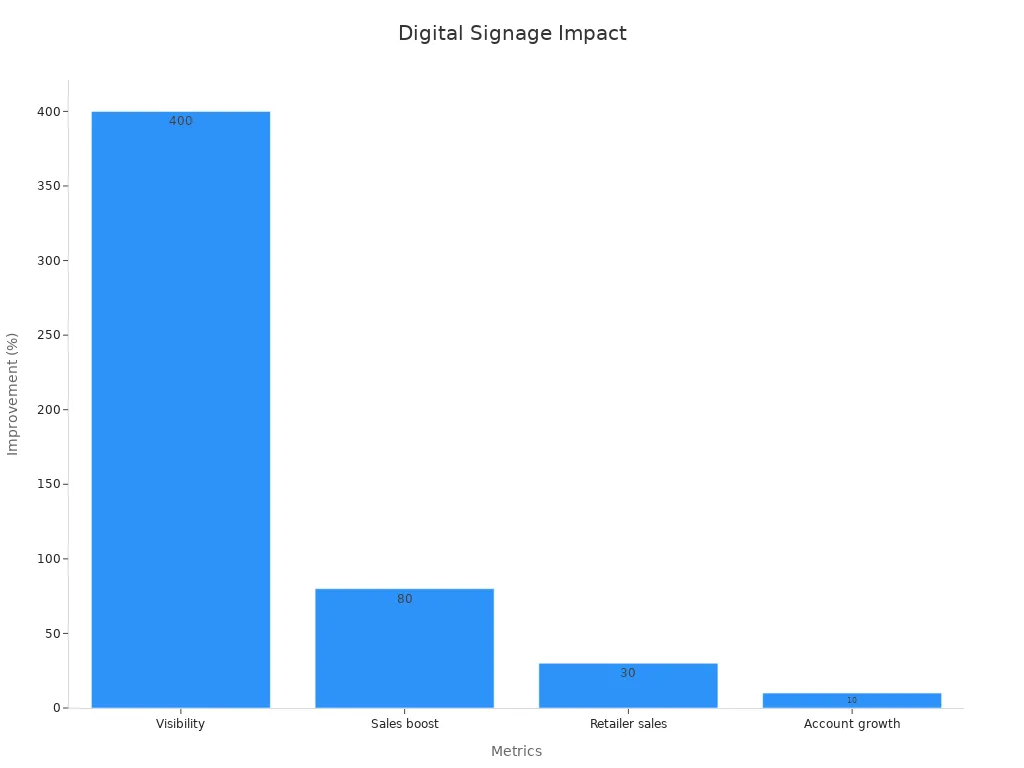
Transportation hubs
Places like airports, train stations, and bus stops use digital signage to share information quickly. These screens show updates about arrivals, departures, and delays. This helps passengers stay informed without searching for details themselves.
Digital signage has many benefits in transportation hubs:
Fast updates: Messages are shared instantly, so passengers get news quickly.
Better engagement: Bright, moving content grabs attention and reduces confusion.
Tracking success: Authorities measure how well the screens work using data.
Smarter planning: Passenger behavior data helps improve marketing strategies.
These screens also show important alerts, like gate changes or emergencies. Their moving images are easier to notice than regular signs. Whether you're at a busy airport or waiting for a train, digital signage makes sure you get the info you need right away.
Educational institutions
Schools, colleges, and universities use digital signage to improve communication and learning. You might see these screens in hallways, classrooms, or common areas. They share announcements, schedules, and event updates in a modern way.
Benefit/Statistic | Description |
|---|---|
Better Communication | Helps students, teachers, and visitors stay informed. |
More Engagement | Touchscreens make learning fun and interactive. |
Instant Updates | Shares campus-wide messages quickly. |
Keeps Attention | Students focus more on digital screens than regular signs. |
Interactive features like quizzes and videos make learning exciting. Studies show 73% of schools think this technology is key for future communication. Students pay five times more attention to these screens, and 65% learn better with visual tools.
These screens also give real-time updates about class changes or emergencies. Whether you're a student, teacher, or visitor, digital signage makes campus life easier and more interesting.
Healthcare facilities
Hospitals and clinics use digital signage to help patients and staff. You’ll see these screens in waiting rooms, hallways, or reception areas. They share health tips, appointment updates, and directions.
Statistic | Percentage |
|---|---|
Hospitals using digital signage | |
Doctors saying it reduces their workload | 64% |
Patients feeling better experiences with hospital messages | 75% |
Patients looking for digital health tools | 78% |
Patients learning health info from digital signage | 52% |
Patients interacting with digital screens in hospitals | 83% |
Viewers remembering messages from hospital screens | 75% |
These screens make communication faster and clearer. Patients wait less and find their way more easily. Doctors also save time by using screens for routine messages.
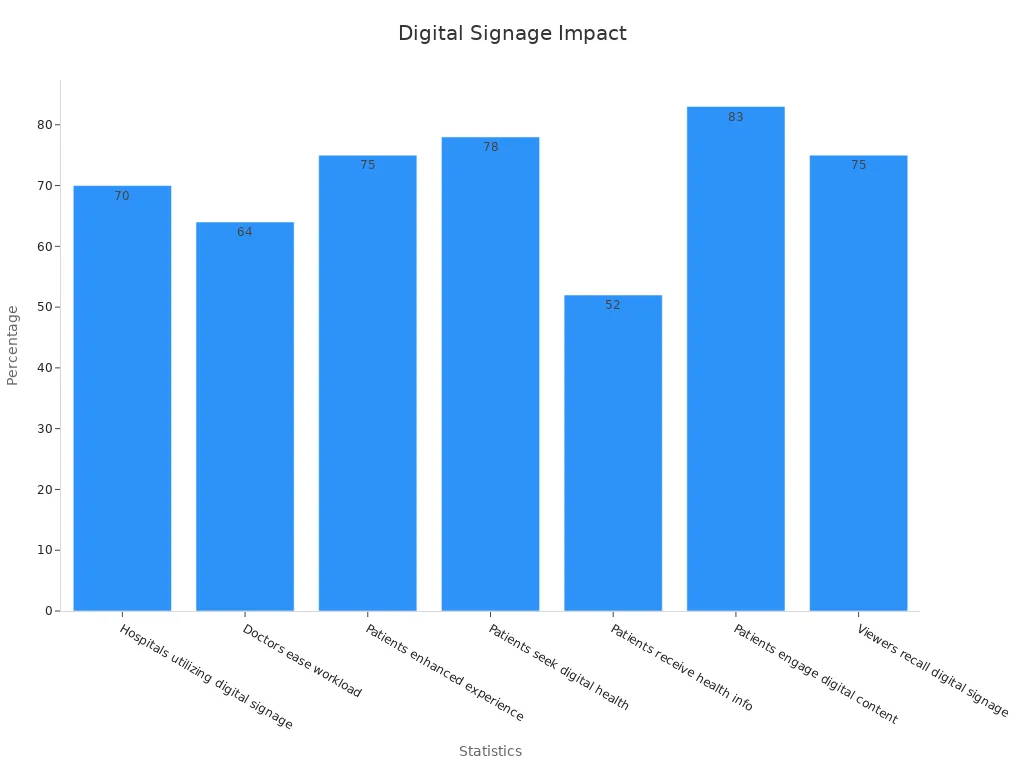
Whether you're a patient needing help or a doctor managing tasks, digital signage improves communication and makes visits better.
Benefits of Digital Signage LED Displays
Exceptional visibility and brightness
Digital signage LED displays are super bright and easy to see. They work well indoors and outdoors, even in sunlight or dark places. LED technology makes colors pop and images clear. This helps businesses stand out in busy areas. Studies show LED screens grab attention better than regular signs. Their sharp visuals make events more engaging and ensure messages reach people.
Tip: Place LED screens where lots of people pass by to get noticed.
Dynamic and engaging content
LED displays let you change content quickly and keep it fresh. Businesses can show deals, daily specials, or fun videos to attract customers. Touchscreens let people explore products or watch demos, boosting sales. Research shows people like interactive and visual content because it’s easier to remember. Using tools like video analytics, screens can adjust to viewers, creating cool experiences that influence buying choices.
Why dynamic content works:
Updates keep messages current.
Interactive screens make shopping fun.
Engaging visuals lead to more sales.
Energy efficiency and cost savings
LED screens use much less energy than older bulbs, saving money. They last a long time, so businesses spend less on replacements. Using LED displays lowers energy bills and helps the planet. The digital signage market is growing fast, showing how popular this tech is. Plus, businesses don’t need printed ads anymore, cutting costs and waste.
Energy-saving benefits:
LEDs use less power, saving money.
Long-lasting screens mean fewer replacements.
No paper ads reduce waste and save cash.
Note: Switching to LED screens can save businesses lots of money every year.
Versatility for indoor and outdoor use
LED screens work well indoors and outdoors, making them very useful. They stay bright and clear in any lighting, like dark rooms or sunny areas. For example, some models, like the 22XE1J, shine at 1,500 nits, perfect for outdoor use. These screens are also tough, with IP56-rated designs that protect them from rain, dust, and sunlight.
Outdoor LED screens are great for grabbing attention in public places. They are perfect for ads, event promotions, and announcements. These screens save energy and last longer than old-style signs, cutting costs. Businesses can trust them to work well anywhere, inside or outside.
Key features of outdoor LED screens include:
Weatherproof designs that handle tough conditions.
Brightness levels that work in any light.
Flexibility for stores, events, and more.
Using LED screens indoors and outdoors ensures your message reaches everyone, no matter where they are.
Better audience engagement and analytics
Digital screens do more than show content—they help you connect with people. Advanced tools in LED screens track how people interact with them. For example, interactive screens can double how much people engage compared to regular ones. In stores, flexible LED screens boost customer interest and sales by 30%. These tools help you create content people enjoy, improving results.
Interactive features like touchscreens and motion sensors make experiences fun. At events, people feel happier when surrounded by 360-degree LED displays. These screens not only grab attention but also collect data about what people like. This information helps improve future marketing plans.
Use Case | Proof |
|---|---|
Retail | 30% rise in customer interest and sales with flexible LED screens. |
Interactive Screens | Double the engagement compared to non-interactive screens. |
Event Displays | Higher satisfaction from attendees with 360-degree LED setups. |
By using data from digital screens, you can improve your strategy and connect better with people. Whether in stores, events, or other places, these tools help you share content that matters.
Digital signage LED screens have changed how businesses share messages. They show moving content, are easy to see, and work anywhere. These screens help stores, hospitals, and other places improve customer experiences. They also increase sales and make work smoother. For example, businesses using these screens see sales grow by 29.5% and brand awareness rise by 84%.
Metric | Effect |
|---|---|
Sales growth | 29.5% |
Better ad recall | 52% |
Customers influenced to buy | 70% |
Shorter wait times in clinics | 33% |
Higher customer satisfaction | 46% |
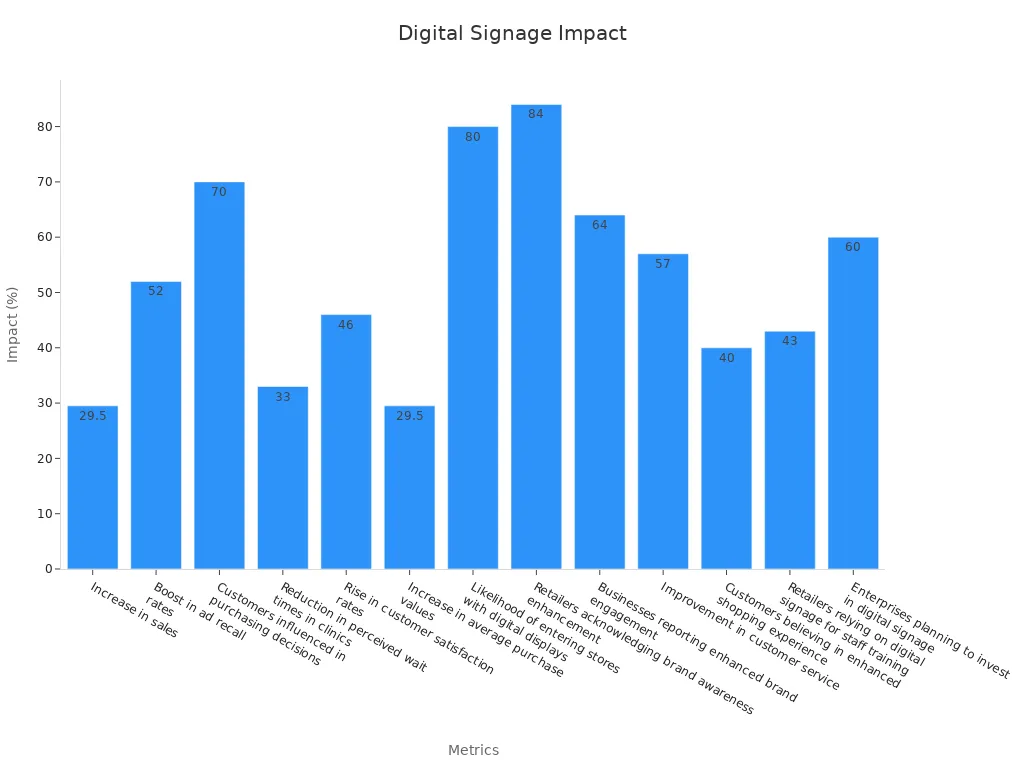
Using digital signage isn’t just about keeping up with trends. It’s about building strong connections with people. Whether you want to engage customers, work more efficiently, or make your brand stand out, these screens are a great choice. Their flexibility and proven results make them perfect for businesses today.
FAQ
What is digital signage LED technology?
Digital signage LED screens use small lights to show clear visuals. They display pictures, videos, and text in bright colors. Businesses use them to share messages in public places. These screens work indoors and outdoors for ads, info, or fun content.
How does digital signage improve customer engagement?
Digital signage grabs attention with moving images and touch features. It shows deals, product videos, or custom messages. Studies say interactive screens get twice the attention of regular ones.
Can digital signage work outdoors?
Yes, outdoor digital screens are tough and very bright. They stay clear in sunlight and handle rain, dust, and heat. You can use them for ads, event updates, or public notices.
Is digital signage energy-efficient?
LED screens use less power than old-style lights. They last longer, so you save money on replacements. Switching to LED screens lowers energy use and helps the planet.
What industries benefit most from digital signage?
Stores, hospitals, schools, hotels, and travel hubs use digital screens. They share news, promote items, and make customer experiences better. Digital signage works well for almost any business.
See Also
Exploring Digital Signage: Key Technologies And Implementation Benefits
Future of Digital Signage: Applications And Leading Models For 2025
The Role of Digital Signage Technology In Modern Communication
Utilizing Digital Signage For Effective Information Presentation
Choosing Digital Signage Screens: Specs And Selection Guidelines

